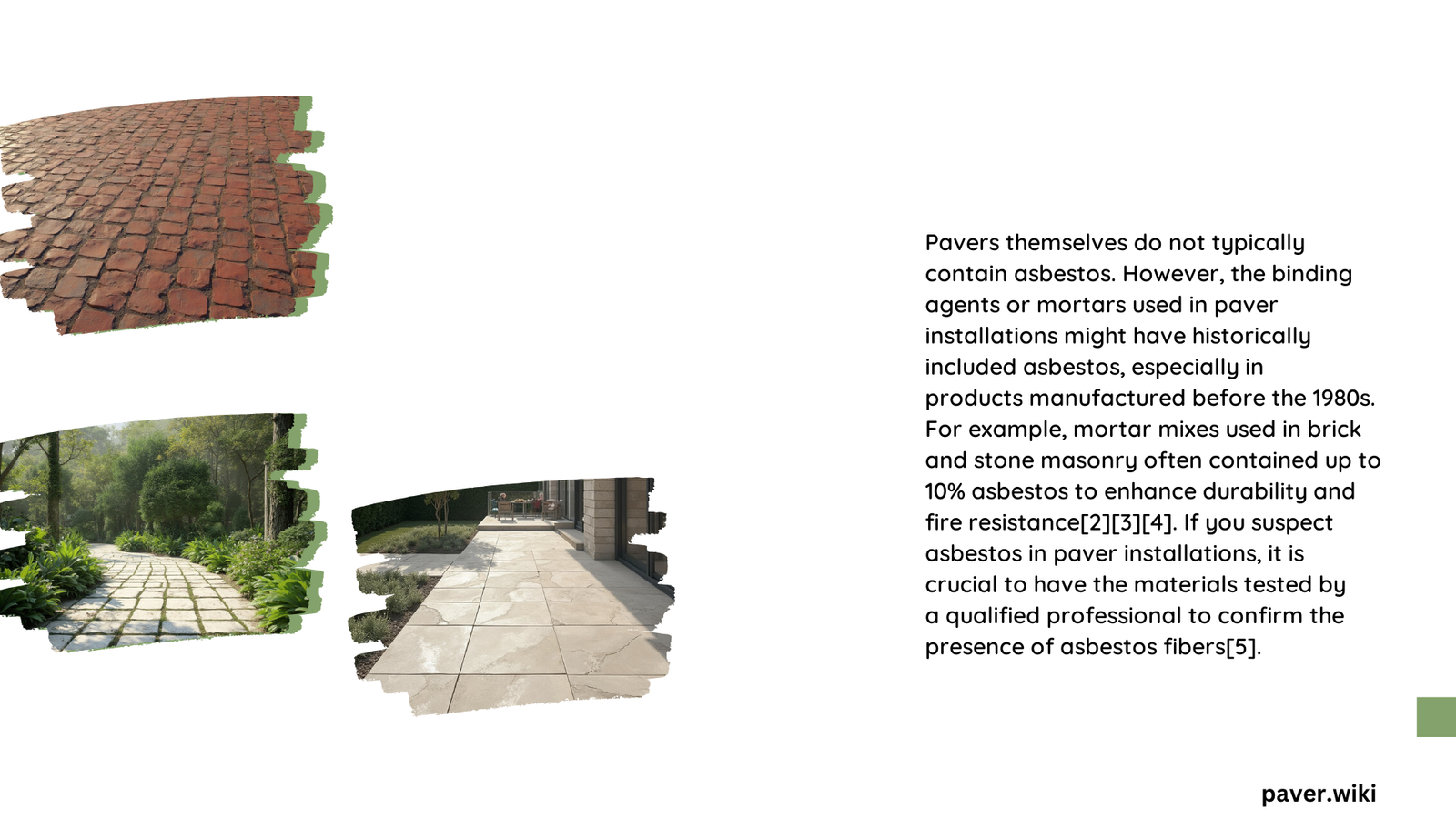Pavers, commonly used in outdoor landscaping and construction, have raised concerns about potential asbestos content. While modern pavers typically do not contain asbestos, older materials or specific types from certain periods may pose risks. This article explores the presence of asbestos in pavers, methods for identification, associated health risks, and testing procedures to ensure safety in construction and renovation projects.
What Types of Pavers Might Contain Asbestos?
Asbestos was widely used in construction materials, including some types of pavers, due to its fire-resistant and durable properties. While not all pavers contain asbestos, certain types produced during specific periods may pose a risk:
- Asphalt-based pavers: Manufactured between the early 1900s and late 1980s
- Cement-based pavers: Produced from the late 19th century until the asbestos ban in the late 1980s
- Roofing tiles and shingles: Often used as pavers in some applications, containing asbestos from early 1900s to late 1980s
It’s important to note that modern pavers produced after the asbestos ban are generally asbestos-free. However, caution is advised when dealing with older installations or materials of unknown origin.
How Can Asbestos in Pavers Be Identified?

Identifying asbestos in pavers requires specific methods and expertise:
- Visual inspection: While not definitive, certain textures or patterns may indicate the presence of asbestos.
- Professional assessment: Trained experts can evaluate the likelihood of asbestos presence based on the paver’s age, type, and appearance.
- Laboratory testing: The most reliable method involves sample collection and analysis using specialized techniques:
- Polarized Light Microscopy (PLM)
- Transmission Electron Microscopy (TEM)
It’s crucial to avoid disturbing suspected asbestos-containing materials without proper precautions and professional guidance.
What Are the Health Risks Associated with Asbestos in Pavers?
Exposure to asbestos fibers from pavers can lead to serious health issues:
- Mesothelioma: A rare and aggressive cancer affecting the lining of the lungs, abdomen, or heart
- Lung cancer: Increased risk, especially among smokers
- Asbestosis: Chronic lung disease causing scarring of lung tissue
The risk of these conditions increases with prolonged exposure and higher concentrations of asbestos fibers. Proper handling and disposal of asbestos-containing pavers are essential to minimize health risks.
How Is Asbestos Testing Conducted on Pavers?
Testing pavers for asbestos involves a systematic process:
- Sample collection: Trained professionals collect samples using proper safety equipment.
- Laboratory analysis: Samples undergo PLM or TEM analysis in certified laboratories.
- Result interpretation: Experts evaluate the presence and concentration of asbestos fibers.
| Testing Step | Estimated Cost | Timeframe |
|---|---|---|
| Sample collection | $100 – $500 | 1-2 days |
| Laboratory analysis | $200 – $1,000 per sample | 3-10 days |
| Result interpretation | Included in analysis cost | 1-2 days |
Factors affecting testing costs and timelines include:
– Accessibility of the pavers
– Number of samples required
– Urgency of results
– Complexity of analysis
What Precautions Should Be Taken When Dealing with Suspected Asbestos-Containing Pavers?
When working with pavers that may contain asbestos:
- Avoid disturbing or breaking the pavers
- Consult with asbestos professionals before any renovation or removal
- Use proper personal protective equipment (PPE) if handling is necessary
- Follow local regulations for asbestos handling and disposal
- Consider encapsulation or professional removal for damaged pavers
How Can Homeowners Ensure Their Pavers Are Asbestos-Free?
To ensure the safety of your pavers:
- Research the installation date: Pavers installed after the late 1980s are less likely to contain asbestos
- Check product documentation: If available, review manufacturer information
- Consult with professionals: Asbestos inspectors can provide expert assessments
- Consider testing: For definitive results, have samples professionally tested
- Stay informed: Keep up-to-date with local regulations and guidelines on asbestos in construction materials
By following these steps, homeowners can make informed decisions about their pavers and take appropriate actions to ensure safety.
